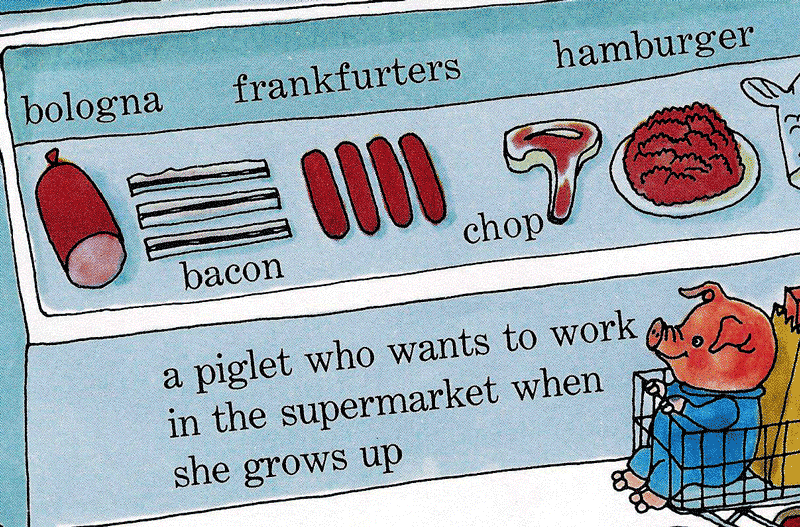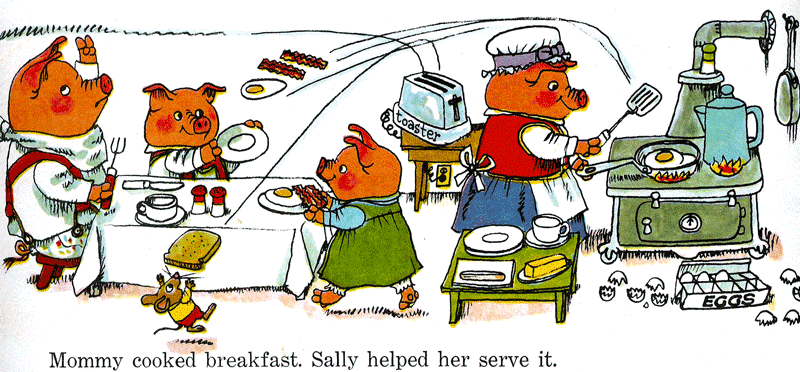 From Richard Scarry’s Best Word Book Ever
From Richard Scarry’s Best Word Book Ever
At first glance, Busytown—the setting of many of Richard Scarry’s beloved children’s books—is not just a hub of industry but a haven of interspecies harmony. Pigs, cats, dogs, rabbits, mice, and the occasional representative of charismatic megafauna cheerfully go about their business Originally published in the sadly defunct Meatpaper, a journal of edible dead animals.
When Meatpaper asked for permission to run some Scarry images with the article, it received a message from his son, Huck, who confirmed the essential innocence of his dad’s busy world: “My father never gave much thought, I think, to the fact that, say, a family of pigs might eat sausage for dinner, or have bacon with their eggs. To Richard, like to any small child, sausage is sausage, and bacon is bacon, and the family at table are you and me.”side by side—studying, building, playing, shopping, and driving the pickle truck. But there’s an unsettling side to these bustling scenes of coexistence: Busytonians are also busy eating each other.
The cute, anthropomorphic creatures who inhabit Scarry’s world love their meat—roasts, hot dogs, and bacon dot his detail-crammed illustrations. Which is only natural, considering that his characters are both animals and, for all intents and purposes, people. In the 1963 classic, Richard Scarry’s Best Word Book Ever, rabbits fry eggs, bears raise chickens, and foxes barbecue hot dogs. The Pig family sits down to celebrate the holidays with a hearty slab of roast beef, a T-bone steak, and a roast turkey that’s bigger than the head of the piglet admiring it.
Such enthusiasm for meat is a little creepy when you realize that pigs are not just among Busytown’s most upstanding citizens—police officers, firefighters, and mail carriers; they’re also one of its favorite foods. Yet Scarry’s pigs do not suffer from the anxiety that plagues anthropomorphized swine such as the Three Pigs and Porky Pig, who never forget that wearing clothes won’t keep them from ending up as someone’s dinner. The pigs of Busytown are blissfully unconcerned where their neighbors’ pork comes from. When Mr. and Mrs. Pig go to the supermarket, one of their piglets sits in the shopping cart, gazing innocently at a meat case displaying bologna, bacon, frankfurters, and what looks like a pork chop. Nearby, the butcher, a raccoon, filets a steak; a ham hock hangs behind him. The little pig, we’re told, “wants to work in the supermarket when she grows up.”
The Pig family’s indifference to the sight of processed pork (not to mention their lack of porcine solidarity) slipped my attention as a kid, but it caught my eye as I was recently reacquainted with Scarry’s greatest hits while reading to an insistent 18-month-old. After some story-time deconstruction, I’ve discerned a logic to his critters’ carnivorousness. In Scarry’s world, as in George Orwell’s Animal Farm, some animals are more equal than others. Some are people, some are animals; the two live entirely separate and distinct existences. This split emerges early in Scarry’s work as an illustrator, such as the 1960 I Am a Bunny, a storybook about Nicholas, an adorable rabbit who wears red overalls, lives in a hollow tree, and likes nothing more than to watch the seasons change. As ducks fly south, squirrels gather nuts, and raccoons prepare their lairs, Nicholas says with a beatific grin, “I like to watch the animals getting ready for the winter.” He may be a furry, four-legged mammal who lives in a tree, but that doesn’t mean he’s one of them. Two of Scarry’s best-known books, What Do People Do All Day? and Busiest People Ever, do not include a single human being.
 From What Do People Do All Day?
From What Do People Do All Day?
A few simple rules govern this world of animals in people’s clothing. Some kinds of animals are only animals and not people—cows and chickens, for instance. Some are only people, such as dogs and cats. Several species have both wild and civilized members, including bears, lions, elephants, and pigs. This leads to some odd juxtapositions. On one page, Kenny Bear the farmer has a chicken coop and a pigsty; a few pages later, a big brown bear sits inside a cage at the zoo. People and animals can not trade places. Kenny Bear can not strip down and join the circus; nor can his farm pig stand on two legs and join the fire department.
The separate-and-unequal logic is also reflected in the unspoken taboos that surround meat eating in Busytown. People can only eat animals, and only animals can become meat. In other words, the Kenny Bear’s pigs will become bacon, but Mr. Pig will not. He can walk past the butcher’s counter secure in the knowledge that he won’t suddenly be stuffed into an oven with an apple in his mouth. He’s a person, and people don’t eat people.
Scarry is usually scrupulous about keeping animals and people of the same species apart. Bears don’t go to the zoo to watch bears, and a pig farmer never keeps pigs. Scarry’s pigs do not suffer from the anxiety that plagues other anthropomorphized swine, who never forget that wearing clothes won’t keep them from ending up as someone’s dinner.However, there is an exception. People may handle meat that comes from their own kind. On the cover of What Do People Do All Day?, a pig butcher slices a giant sausage. In “Count With Hooty Owl,” a page in the compendium Richard Scarry’s Best Storybook Ever, a pig sells “seven fat hot dogs” to Hooty and his mother. Maybe they’re kosher all-beef dogs. Maybe.
Nonetheless, people are generally forbidden from eating animals of the same species. In my admittedly incomplete scrutinizing of Scarry’s body of work (he wrote and illustrated over 300 books), I’ve seen only one obvious instance of this rule being broken. In “Mother’s Work is Never Done,” a story in the 1968 version of What Do People Do All Day?, Mommy Pig stands at a hot stove, serving her brood slices of bacon for breakfast. The story is no longer in the current version of the book, presumably removed due to its outdated gender roles rather than its depiction of porcinophagy.
But there are a few close calls with cannibalism. In “Pierre, the Paris Policeman,” a story from Busy Busy World, a jewel thief crashes through a restaurant, surprising patrons and overturning tables. A pig is caught with his fork in midair, a pink morsel still on the tines. What looks like a small ham sails over his shoulder. Perhaps he has just been saved from upsetting the delicate balance of human and animal appetites that keeps his busy world going. Or perhaps he was simply eating rabbit—the kind that doesn’t wear overalls.